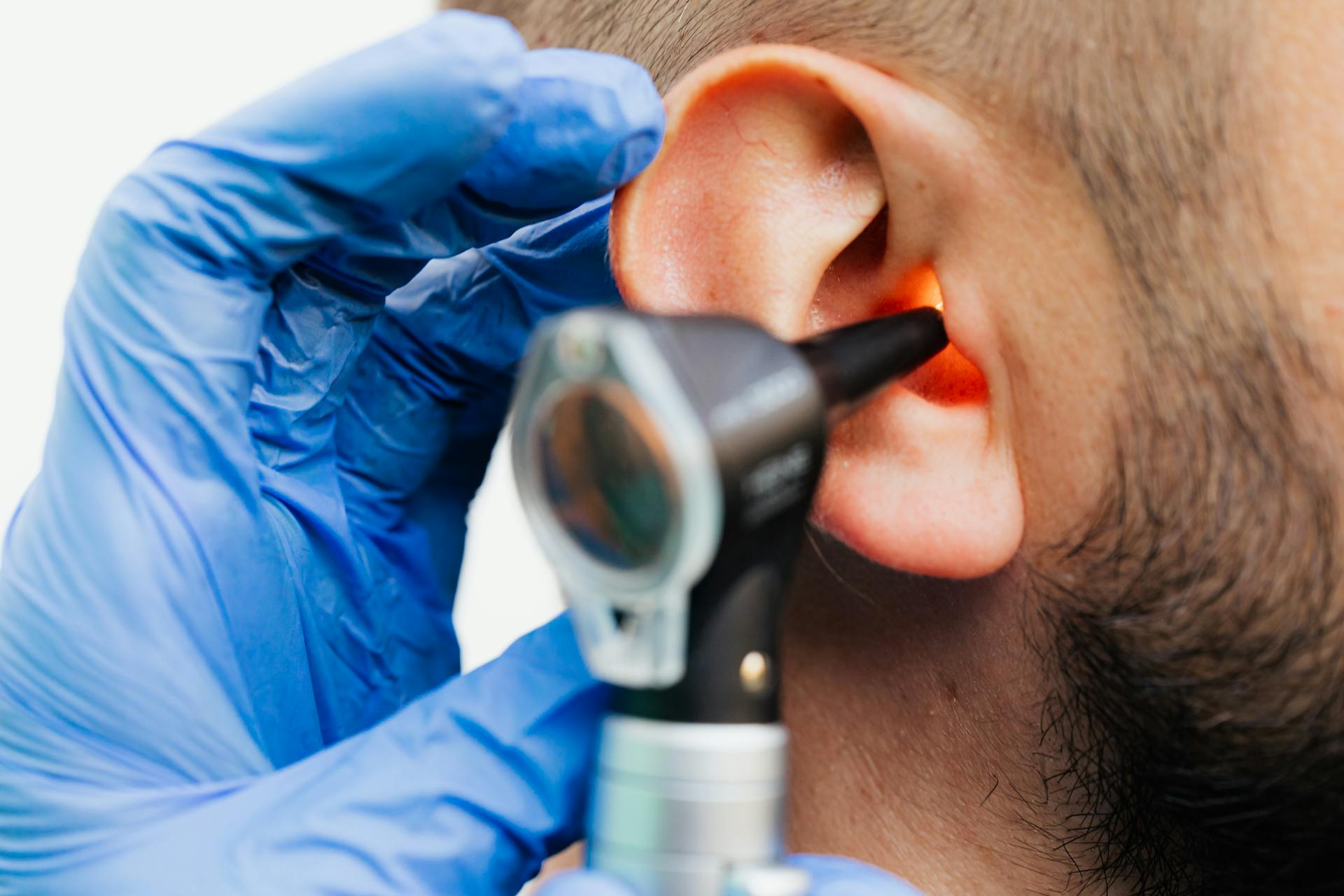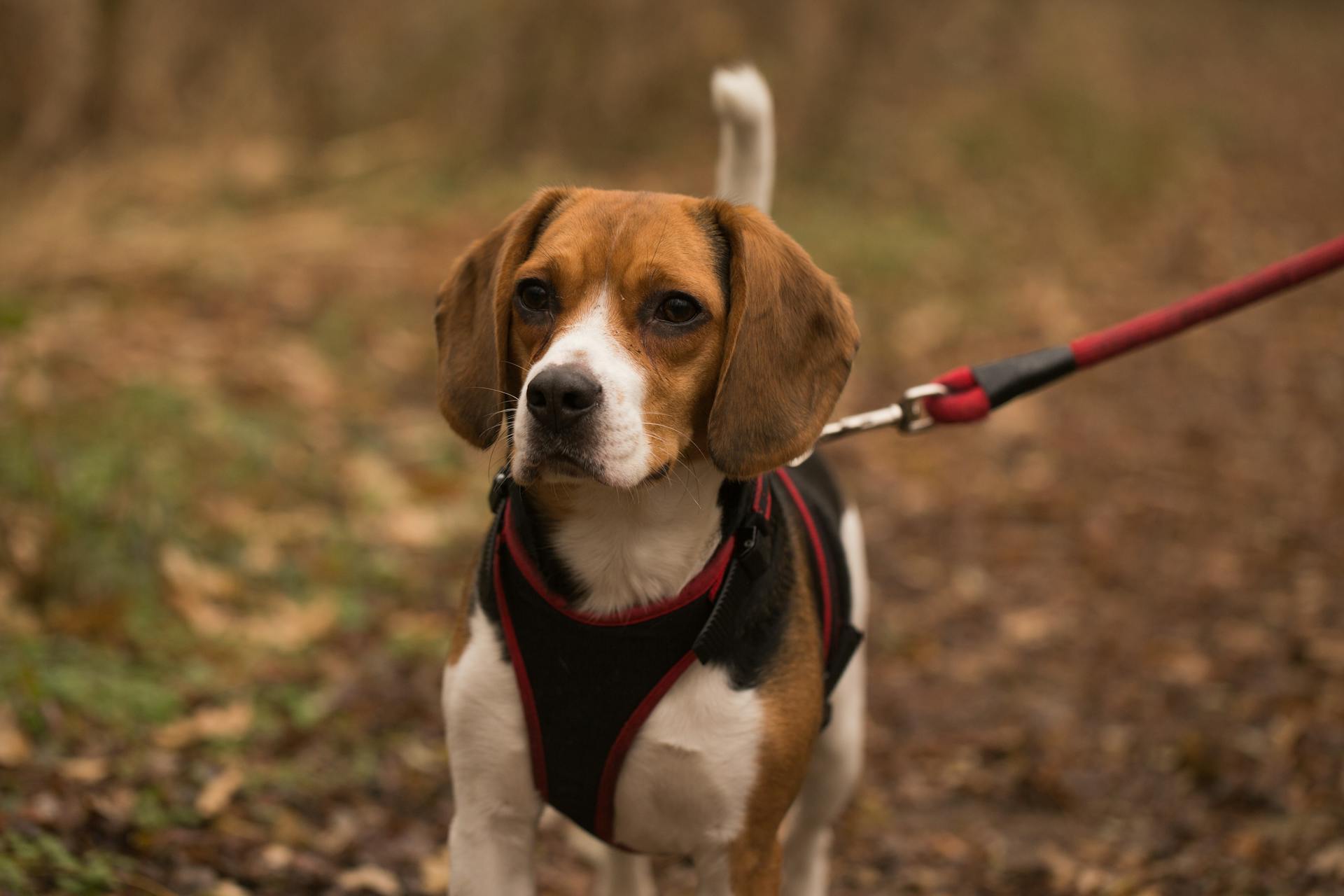
Dog ear infections are a common issue that can arise after grooming, especially if proper precautions aren't taken.
A dog's ear canal is a warm, moist environment that's perfect for bacterial growth, making infections a real risk.
Regular grooming can push bacteria and debris further into the ear canal, increasing the risk of infection.
In some cases, dogs may even develop a condition called otitis externa, a painful and potentially serious infection of the outer ear.
Explore further: Dog Ear Infection Packing
Causes and Prevention
Dog ear infections can be a real pain, especially after grooming. Moisture is a common cause of ear infections, so be sure to thoroughly dry your dog's ears after swimming and bathing.
The canine ear canal is more vertical than that of a human, making dogs more prone to ear infections. Factors that may predispose your dog to ear infections include allergies, endocrine disorders, autoimmune disorders, wax buildup, foreign bodies, injury to the ear canal, and excessive cleaning.
Here are some common causes of dog ear infections:
- Foreign bodies (such as grass awn or foxtails) that get into the ear
- Ear mites
- Excessive moisture from bathing or swimming
- Food allergies
- Environmental allergies
- Endocrine issues such as hypothyroidism
- Autoimmune diseases such as pemphigus, lupus, or vasculitis
- Polyps (fleshy growths inside the ear canal)
- Certain types of cancer
- Trauma to the ear
What Causes?
Ear infections in dogs can be caused by a variety of factors, including bacteria, yeast, and parasites. The canine ear canal's unique shape, which forms an L-shape, makes it more prone to holding in fluid and creating an ideal environment for these microorganisms to grow.
Moisture is a significant contributor to ear infections, as it allows bacteria and yeast to thrive. This can be caused by excessive bathing, swimming, or even just living in a humid climate.
Allergies can also play a role, with about 50% of dogs with allergic skin disease and 80% of dogs with food sensitivities experiencing ear disease. I've seen firsthand how allergies can lead to ear infections in dogs, so it's essential to keep an eye out for signs of allergies in your furry friend.
Other factors that may contribute to ear infections include endocrine disorders, such as thyroid disease, and autoimmune disorders. These underlying conditions can compromise the ear's natural defenses, making it more susceptible to infection.
For more insights, see: Can Allergies Cause Ear Infections in Dogs

Here are some common causes of ear infections in dogs:
- Foreign bodies, like grass awns or foxtails
- Ear mites
- Excessive moisture
- Food allergies
- Environmental allergies
- Endocrine issues like hypothyroidism
- Autoimmune diseases
- Polyps or certain types of cancer
- Trauma to the ear
By understanding the potential causes of ear infections in dogs, you can take steps to prevent them or address the underlying issues if an infection does occur.
Preventing
Preventing ear infections in dogs is crucial to keep them happy and healthy. Regular grooming, ear cleaning, and ear maintenance are essential parts of pet care.
Cleaning your dog's ears at least once a month is recommended to prevent infections. You can use a vet-approved ear cleaning product or mix half water and half white vinegar as a homemade solution.
Excess moisture is a common cause of ear infections, so make sure to thoroughly dry your dog's ears after swimming and bathing. This is especially important if your dog loves to swim.
Cleaning the external ear flaps with dog ear cleaning wipes or cotton swabs can also help prevent infections. Just be sure to avoid using paper towels or cotton balls that may leave fibers behind.
Discovering and treating the underlying cause of ear infections, such as allergies to food proteins, dust mites, or seasonal allergens, can provide a long-term solution to prevent recurring infections.
Curious to learn more? Check out: Why Is My Dog's Ears Cold?
Symptoms and Signs
Symptoms of dog ear infections can be quite subtle, but they're often accompanied by a buildup of wax and discharge in the ear canal. Some dogs may show no symptoms at all.
You'll likely notice your dog scratching at their ears or shaking their head if they have an ear infection. This is a clear sign that something's wrong.
Redness and swelling of the ear canal are also common symptoms. You might notice a dark discharge or an unpleasant odor coming from your dog's ears.
Itching, pain, and crusting or scabs in the ears are all potential signs of an ear infection. In some cases, you might even see a head tilt or a buildup of scabs around the ear flap.
Here are some common signs of dog ear infections:
- Redness
- Odor (a yeasty, corn chip-like smell)
- Itching/scratching at ears
- Pain
- Shaking of the head
- Head tilt
- Discharge
- Scabs or crusting around the ear flap
- Swelling of the ear flap (aural hematoma)
Diagnosis and Treatment
Your veterinarian will need to test the ear debris or perform scans of your dog's ear to choose the right treatment for your pup. These tests may include cytology, culture/sensitivity testing, blood testing, and skull X-rays, CT scan, or MRI.
A thorough history of the problem is essential for your vet to determine the best course of treatment. This includes providing information about your dog's symptoms, allergies, medication, diet, ear cleaning habits, and recent activities.
Your vet will likely prescribe topical or oral medications, or even surgery in severe cases. In uncomplicated ear infections, treatment usually lasts two weeks, but your dog should have some relief from symptoms within a few days.
Precise Diagnosis Needed
A precise diagnosis is crucial for treating your dog's ear infection effectively. Your veterinarian will need to take a thorough history of the problem, including the duration of symptoms, any allergies or underlying medical conditions, and recent activities.
It's essential to provide your vet with as much information as possible, especially if this is your dog's first ear infection or if you're seeing a new vet. Your vet will want to know about your dog's diet, ear cleaning habits, and any medications they're taking.
If this caught your attention, see: Why Are My Dog's Ears Cold?

Your vet will perform a physical examination, which may include a visual assessment, examination with an otoscope, and gentle palpation of the ear. In severe cases, they may recommend sedating your dog to facilitate examination deep within the ear canal.
Here are the key things your vet will evaluate during the exam:
- Visual assessment to look for signs such as redness, swelling, and discharge
- Examination with an otoscope to evaluate the ear canal and eardrum
- Gentle palpation of the ear to assess level of pain
- Microscopic examination of samples taken by swabbing the ear
- Culture of samples from the ear
- Biopsies or X-rays in severe or chronic cases
Your vet will also test the ear debris or perform scans to choose the right treatment for your pup. These tests may include cytology, culture/sensitivity testing, blood testing, and skull X-rays, CT scans, or MRI.
How Are Treated?
Your veterinarian will thoroughly clean your dog's ears using a medicated ear cleanser. This is an important step in treating dog ear infections.
Typical treatment for dog ear infections involves prescription medication. Your veterinarian may prescribe ear drops, oral antibiotics, or anti-inflammatory medications, depending on the severity of the infection.
In most cases, uncomplicated ear infections resolve within 1-2 weeks of starting treatment. However, severe infections can take months to resolve or may become chronic problems.

If your dog has a severe chronic ear infection, your veterinarian may recommend surgery such as Total Ear Canal Ablation (TECA). This surgery removes the ear canal and diseased tissue, preventing the recurrence of infection.
It's essential to follow your veterinarian's instructions closely and return for recommended recheck appointments. Lapses in treatment can lead to the recurrence of the infection, so be sure to finish the full course of medication, even if your dog appears to be getting better.
Types and Characteristics
A dog ear infection can be caused by various factors, including grooming. The anatomy of a dog's ear starts outside the head and moves in as follows: Ear flap (pinnae), ear canal, ear drum, middle ear, inner ear.
There are three types of ear infections in dogs: otitis externa, otitis media, and otitis interna. Otitis externa is the most common type, as it's the most exposed part of the ear.
Here are the three types of ear infections in dogs:
- Otitis externa: inflammation of the ear canal
- Otitis media: inflammation of the middle ear
- Otitis interna: inflammation of the inner ear
What Are?

A dog ear infection is a common issue that can affect any dog, but it's more likely to happen in certain breeds. Basset Hounds, Chinese Shar-Pei, Labradoodles, Beagles, and Cockapoos are the top five breeds that are prone to ear infections.
A healthy dog ear is clean and dry, but when debris builds up or the ear canal is compromised, bacteria and yeast can overgrow and cause an infection. This is because it's normal for small amounts of microscopic bacteria and yeast to live in a dog's outer ear canal.
The outer ear, specifically the area known as otitis externa, is the most common area affected by ear infections in dogs. This is a key area to keep clean and dry to prevent infections from taking hold.
Types of
A dog's ear is made up of several parts, starting from the outside and moving inwards: the ear flap (pinnae), ear canal, ear drum, middle ear, and inner ear.

Otitis, the medical term for ear infections in dogs, is divided into three main types based on the location of the infection.
Otitis externa is the most common type of ear infection in dogs, affecting the ear canal. This is because the ear canal is the most exposed part of the ear to the outside world.
Otitis media affects the middle ear, while otitis interna affects the inner ear. Both of these types are less common than otis externa.
Ear infections can be acute, meaning they develop quickly, or chronic, meaning they recur frequently.
Intriguing read: Types of Dog Ear Infections with Pictures
Frequently Asked Questions
How do you clear an infected dog's ear?
To clear an infected dog's ear, a medicated ear cleaner or topical medication is typically used, and in severe cases, oral antibiotics or anti-inflammatory medications may be prescribed by a veterinarian. Your vet will usually recommend a treatment plan tailored to your dog's specific needs.
Can a dog ear infection heal itself?
Unfortunately, most dog ear infections do not heal on their own and can lead to serious complications if left untreated
Sources
- https://www.akc.org/expert-advice/health/dog-ear-infections/
- https://www.dailypaws.com/dogs-puppies/health-care/dog-conditions/dog-ear-infection
- https://www.petmd.com/dog/conditions/dog-ear-infections
- https://www.vetniquelabs.com/blogs/vets-corner/how-do-i-know-if-my-dog-has-an-ear-infection
- https://vcahospitals.com/know-your-pet/instructions-for-ear-cleaning-in-dogs
Featured Images: pexels.com


